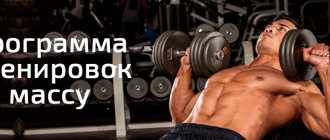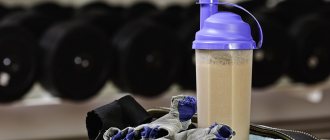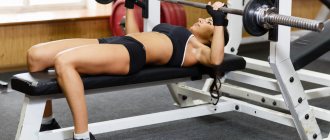It's no secret that splits are more effective for gaining muscle mass than full-body workouts. Often the priority is a 3-day mass training program that is convenient to follow during the work week. And this is completely justified. Such a program will never let you down and will help you build impressive muscles that are worthy of admiration.
Although training on this system alone is not enough to fully realize its full potential in 3 days a week. But don’t despair, I will guide you. I will provide the perfect 3 day split program for fast muscle growth for men.
It is impossible to reap the benefits of split training without a competent, comprehensive approach. This means that everything needs to be taken into account, from the choice of exercises, the combination of muscle groups, the frequency and intensity of training, to the length of rest between sets. Otherwise, it will not be possible to achieve the expected results and justify all the hopes placed on this complex.
The essence of the program for beginners
The tasks of beginners who first cross the threshold of the gym are similar. Guys want to improve, become better, have a healthy and attractive appearance.
In more detail, the essence of any training program for beginners is:
- development of general training ability - the body's endurance during training, the ability to quickly recover after exercise;
- improving muscle coordination, training exercise techniques;
- increasing efficiency - increasing the volume of the program;
- increasing strength indicators.
As the novice athlete achieves these goals, he approaches others - gaining muscle mass, burning fat, improving overall health.
How to write a program correctly
The most effective training program will be one based on the individual characteristics of the beginner.
When selecting exercises for a beginning athlete, it is necessary to take into account 3 main factors:
- Age. This factor determines the list of acceptable exercises. For example, it is better for a 16-year-old teenager to refrain from performing heavy deadlifts.
- Health status. A person suffering from varicose veins should reduce the load on their legs.
- Regime and lifestyle. When creating a program for an office manager and a loader at a factory, different approaches are needed.
Training schedule
The training program for a beginning athlete looks something like this:
| Day of the week | Week #1 | Week #2 |
| Monday | A | B |
| Tuesday | rest | rest |
| Wednesday | B | A |
| Thursday | rest | rest |
| Friday | A | B |
| Weekend | rest | rest |
Training takes place on Monday, Wednesday and Friday - three times a week. The two types of training alternate every other time. This schedule of training in the gym is the most optimal: the muscles are well pumped during the workout and have time to recover after the load.
A HEALTHY HABIT IS TO RECORD THE RESULT
For greater efficiency, get yourself a useful habit - keep a diary of training and rest every day. Record your future plans and everything that happened to you in it:
- Lay out your training plan from start to finish. Write down the exercises, working weights, number of approaches and repetitions, breaks between exercises, evening jogging. If the training did not go according to plan, record the results you worked out.
- Make a meal plan for the day, counting food in grams, calories, proteins and carbohydrates. Record the amount of fluid you drink per day. Record everything you ate and drank, and calculate the final result. To do this, it is recommended to study nutrition for athletes in more detail, make a list of foods with a low glycemic index and high protein content. Create a blacklist of products.
- Every day, measure the circumference of different parts of the body and weight with a centimeter, and record the numbers in a diary.
- Make notes about how you feel on rest days. If you feel unwell, try to find the cause in yesterday. Perhaps you will see it in the column with the liquid you drink during the day. Record your sleep time.
Once a month, take the time to analyze your notes, highlight the most effective results and vice versa. Thus, an understanding will come about quality training and nutrition. In the meantime, this understanding is not available, check out the recommended workout by day of the week. Learn nutrition for beginner bodybuilders.
What muscles can you train in one workout?
Here is the most common and logical option:
| Monday | Back, biceps |
| Wednesday | Chest, triceps |
| Friday | Legs, shoulders |
The main muscle groups are distributed by day. To each large group, small muscle groups are added that take part in the main training (excluding training of the shoulders and legs). It's simple: let's take chest training, which includes exercises based on pushing (squeezing) weight away from the chest. This function is performed by the triceps, which should be trained together with the pectoral muscles.
We adhere to the same principle when planning a back and biceps workout. The shoulders are not involved in pumping the legs, but Friday is the most convenient day to ensure a high-quality load on the deltoids.
The above program should not be taken as a postulate and there is an alternative plan for training muscle groups. As follows:
| Monday | Chest, biceps |
| Wednesday | Back, triceps |
| Friday | Legs, shoulders |
This option is less popular. Its supporters consider it pointless to train a secondary muscle after it has already been involved in working out the main muscle groups. Therefore, biceps and triceps have moved in the table.
The third and no less effective training option for beginners: working out all the main muscle groups in one workout. This plan is the most energy-intensive and is not suitable for everyone.
Food for mass
During this effective 12-week training, you will gain muscle mass and some fat, and also significantly increase muscle strength.
Increase volumes gradually to get maximum benefits. A much easier option is to lose some fat after training rather than trying to achieve significant results while in a deficit.
If the weight persists, here are some simple ways to add a good amount of calories to your diet:
- Butter
- Cream cheese
- Sour cream
- Whole milk
- Cream
- Cheese in combination with any food
- Protein shakes
- Peanut butter
- Olive oil
- Extra salad dressing
All these products allow you not only to diversify your diet. but also add a significant amount of healthy fats. When achieving a goal, this option is more preferable than going to McDonald's.
By eating clean and healthy, you will feel better and have more energy to exercise. Your stomach will tell you: “Thank you!”
The main “focus” of this system is not training, but appropriate nutrition and recovery.
This bulking program may be a little overkill, after the end of 12 weeks you may want to cut back on your calories a bit. But the strength and muscle size gained is definitely worth it.
Where to start training
The beginning of any workout involves a warm-up.
A cardio machine is perfect for these purposes. Beginners should prefer an exercise bike. Cardio warm-up usually takes 5-10 minutes.
Then move on to swings, body turns, and pull-ups to the sides. Everyone remembers this warm-up from their school days: we start with the neck, then the shoulder joint, elbow, and wrist.
It is especially worth paying attention to the lower back - this area of the body bears the main load during the training process. Bend to the sides, bend back, stretch to the side, do crunches, rotate your torso. We finish the warm-up - rotate our hips, work our knees and feet.
Training program for beginners
The above programs can serve as an excellent guide for a novice athlete. However, before starting classes, it is necessary to adjust the material based on individual characteristics (age, health, lifestyle, etc.).
Split training program for beginners
A three-day split for a beginner might look like this:
| Monday (back muscles, biceps) | |
| Warm-up | 5-10 minutes |
| Deadlift | 2 sets of 8 times |
| Bent-over barbell row | 3 sets to the maximum |
| Biceps curl (with barbell) | 2 sets of 12 times |
| Abs workout | 3 sets to the maximum |
| Stretching | 5 minutes |
| Wednesday (pectoral muscles, triceps) | |
| Warm-up | 5-10 minutes |
| Bench press with wide arms | 5 sets of 5 times |
| Bench press with narrow arm position | 2 sets of 12 times |
| French press | 3 sets of 12 times |
| Abs workout | 3 failure sets |
| Friday (legs and shoulders) | |
| Squats | 3 sets of 6 times |
| Leg press in the simulator | 2 sets of 18 reps |
| Seated calf raise | 3 sets of 15 times |
| Dumbbell raises | 2 sets of 12 times |
| Army press | 3 sets of 8 times |
| Stretching | 5 minutes |
After Friday, the body needs rest for 2 days. This type of training can be continued for several months, over time becoming familiar with the new principles of training.
Circuit training with machines for beginners
Circuit training in the gym is the best option for a beginner. Among the obvious advantages of such activities:
- the ability to master exercises from the point of view of the technicality of their implementation;
- gradual adjustment of mental-muscular coordination;
- high-quality preparation of muscles for more significant loads.
For girls, I recommend reading the article “Circuit training for girls.”
With this type of training, the fitness trainer usually adheres to the “big to small” principle. However, if you believe in practice, not every beginner has enough energy and physical endurance to work out other muscle groups after heavy exercises on the lower part.
The most favorable option for circuit training for a beginning athlete is as follows:
- After a five-minute warm-up, we completely perform the first exercise on the back muscles (in 2-3 sets of 12-15 repetitions). Having completed one set, we rest. Then we proceed to chest exercises (2-3 sets of 12-15 repetitions). Then we move on to the shoulders and continue according to the same principle. This way you can train for the first two weeks.
- With the beginning of the third week, we add one more exercise for the main muscle groups (back, chest). Then we continue to adhere to the same principle: after performing 2 exercises on the back muscles (in 2-3 sets), we begin working on the chest. We don’t rush with the legs: we leave one previous exercise (squat or bench press). The same applies to small muscles - we perform one exercise each for biceps, triceps and shoulders.
Cardio workout for beginners
For a beginner athlete, during cardio training, it is important to perform a block of exercises that would allow evenly loading all areas of the body. This goal is perfectly achieved by doing aerobics and dancing. In the process of performing a specific element, you should maintain tension in those muscle groups that are currently tense - this will increase the effectiveness of the exercises.
A cardio training complex for a beginner may include the following exercises:
- Run in place. We grab our hips with our heels.
- Jumping (legs spread/closed). You can also use your hands, simulating the rotation of a jump rope.
- "Jumping jack" - wide jumps. At the same time we raise our hands.
- Running with high hips.
- "Mill".
- Leg-scissor jumps. We jump up and change legs in a forward and backward direction. We press our hands to the body.
- "Pendulum". The body is vertical to the floor, hands are pressed to the shoulders, one of the legs is supporting, the other is moved to the side. Alternately change the emphasis on the leg.
- Feet together, jump to the sides.
- Let's box.
- We squat deeply, our back is straight, we throw our arms out in front of us.
A beginner should give preference to such cardio training during the first two months. After this, you can connect running in the fresh air, running on sports simulators, cycling, exercise bike, jumping rope, etc.
Features and specifics of work
In order to start working hard on your own body, you should familiarize yourself with basic knowledge on the topic. Mindlessly and uncontrollably performing the most effective movements will not produce any effect, so remember the following.
- The complex involves working with such a load that you could lift 6-12 times, depending on your physical fitness and body capabilities. Isolation exercises can be repeated up to 15 times.
- Strictly follow the prescribed numbers, because if you do less than 6 times, the result will be an increase in strength indicators, but not in volume. If you add repetitions above 12, the effect will manifest itself as an increase in muscle endurance.
- To build mass, exercises should be done to failure. This means that if you do it the 8th time, but you physically can’t do the 9th, this is a refusal. If you don't train to failure, there will be no muscle growth.
- The result also depends on the number of approaches. If you are a pro, then there should be 2-4 of them, and for beginners we recommend stopping at 1-2 sets.
- Bodybuilding involves working in the “negative” phase. This means that, for example, when lifting a barbell with weights for biceps, the lifting phase will take 1 second, but the lowering phase should be extended to 3 seconds. This regime is due to the fact that in the “negative” phase, muscle fibers receive more microcracks. Injury causes muscle growth.
How to Make a Workout Program Work
To achieve this goal, a beginner should adhere to the following rules during training:
- We focus on the form of execution. First, we determine our working weight, which will allow us to perform the exercise in the proper form (technically). After confidently completing the entire volume of exercises, you can move on to a gradual progression of working weights.
- We perform all the sets and progress in loads. We are talking about volume-strength progress, which involves a consistent increase in load while maintaining the technique and numerical parameter of the exercise.
- We follow the plan and don’t experiment.
By following these three principles in the gym, a beginner can rightly count on good athletic results.
Selecting projectile weight
If you are just starting to exercise, or have had a long break, you should not use maximum weights. In this case, there is a high probability of injury.
In addition, if you are new to training, you first need to develop technique, and with heavy weights this is very difficult to do.
First, the muscles must learn the correct pattern of movement and get used to the load. After this, you can build up a lot of weights - after all, in order to make muscles grow, you still need to work with full dedication, and you can’t do this without really heavy weights.
Read this article on how to increase weight in exercises such as the bench press.
When you get to this stage, the weight of the apparatus in each exercise should be such that you work the target muscles to failure for the required number of repetitions. Ideally, at the end of each set you should feel like you can't do any more reps.
Do you need a coach?
If it were not for the issue of price, most beginners would end up training in a gym with a personal trainer. There are several reasons for this and they are quite objective:
- training with a trainer gives beginners confidence. After all, many beginning athletes are shy, suffer from complexes, and experience a feeling of fear;
- the coach helps the beginner avoid unpleasant situations. Injury in the gym can be caused by an incorrect assessment of one’s own strength, violation of the technique of performing an exercise, and inability to use exercise equipment and equipment;
- The trainer is able to create an individual training program for the client. At the same time, the professional takes into account the beginner’s current level of physical fitness, his goals, wishes, and body characteristics;
- the coach, observing the client from the side, can point out to the novice athlete a mistake, teach the correct technique or make the necessary amendments to the program;
- according to statistics, with a coach, a beginner achieves good, sometimes excellent results much faster;
- a coach motivates a beginning athlete, sets him up for training, supports him, and prepares him for future success.
However, to answer the question “Do I need a coach?” Each aspiring athlete must independently weigh the pros and cons, take into account his recent relationship with the sport and evaluate his own internal state.
The following training programs for beginner athletes can serve as decent models when creating an individual program. The choice of exercises, number of repetitions, sets and pace of exercise are selected taking into account the individual characteristics of the body.
Regardless of the type of training and training regimen, it is important not to be guided by three basic principles aimed at mastering technique, progressing in working weights, following a plan and not experimenting. Such an approach will not only prevent the development of unpleasant situations, but also ensure the achievement of the set goal, no matter how unattainable it may seem.
Feelings while doing the exercise
While doing the exercises, you need to mentally concentrate on the work of the target muscles.
For example, if you are doing a barbell clean, you should focus your attention on the pectoral muscles and feel how they do their job, taking the lion's share of the load during the rise and slow, controlled lowering of the apparatus. This is a very important point that must be kept in mind in order to get really good results from your training.
If you're just starting out and your muscles are doing a lot of hard work that they're not used to, they'll be pretty sore in the first few weeks. This is absolutely normal, but the pain goes away over time.
In order to avoid pain or simply reduce it to a minimum, you need to enter the training process as smoothly as possible - you can start with a light half-hour workout with minimal weights, and then gradually increase the size of the weights.











